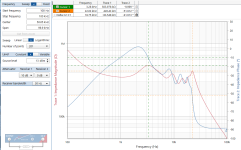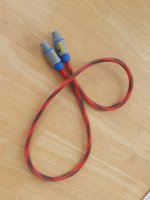We can play with that. Just have to fix my crackling one first.And if recording replayed through the same pair of ESL63, it would probably be the first true symmetrical record/replay chains ever.... I'd like to hear that. Same room, same speaker position for rec/play.
//
Really? I always thought the pastic helped damp resonances. Steel must ring like a bell!New top and bottom plate with steel
Jan
I am a complete noob when it comes to Quad ESLs, so this question may be silly, but: why not drive the estat panel directly from a high-voltage amplifier instead of going through a transformer?
You missed an essential word: WITH.Really? I always thought the pastic helped damp resonances. Steel must ring like a bell!
Jan
That makes all the difference. Different from all steel. It's a hybrid with steel.
Ahh, that sounds better. So the steel is there to make the frame sturdier.
I'm building a vibration sensor, curious what is going on in that frame and the other bits and pieces.

Jan
I'm building a vibration sensor, curious what is going on in that frame and the other bits and pieces.
Jan
Last edited:
It makes a sturdier bottom and top plate. The sides is a different matter.
https://audioxpress.com/article/you-can-diy-edd-a-direct-drive-amplifier-for-electrostatic-speakersI am a complete noob when it comes to Quad ESLs, so this question may be silly, but: why not drive the estat panel directly from a high-voltage amplifier instead of going through a transformer?
Jan
My change to long, metric thread connections of the top/bottom to the sides were intended to increase the connection strength between the two. Not sure how much it matters, but it seems better now. My top and bottom plates are 3D printed reinforced ABS. And in my ESL 31.5 design the top/bottom plates are only 400mm wide so there's less flex anyway. We'll see.It makes a sturdier bottom and top plate. The sides is a different matter.
But I really want to measure if there is a change, and to what effect.
Jan
If I get this correctly, the amps are separate from the speakers. In other words, you have some cables running from the amp through your living room to the speakers, and these cables carry several thousand volts. You don't have pets, do you?
The cables are 75cm long (less than a meter) and the amps sit next to the speakers.
The main reason to keep the cables short is to limit the parasitic capacitance that would consume some of the output current.
It is beyond me why people get all excited about a few kV in a cable. There's no fundamental difference between +5V en 5kV - it's only a matter of scale. Adapt the isolation and Bob's your uncle. And make it red of course, that seems to scare people anyway.
Jan
The main reason to keep the cables short is to limit the parasitic capacitance that would consume some of the output current.
It is beyond me why people get all excited about a few kV in a cable. There's no fundamental difference between +5V en 5kV - it's only a matter of scale. Adapt the isolation and Bob's your uncle. And make it red of course, that seems to scare people anyway.
Jan
Attachments
Last edited:
That's how a lot of animals warn their predators that they are venomous or toxic 👍And make it red of course, that seems to scare people anyway.
There's a reason why traffic light colors are what they are. It wasn't not really an arbitrary decision.
I never heard a general exclaiming 'dark green alert!' ;-)
Jan
I never heard a general exclaiming 'dark green alert!' ;-)
Jan
/OT Warning
Why would red be the danger color?
Could it have to do with blood being red?
If you see blood on someone or yourself, you know there's a problem, possibly deadly so.
An evolutionary thing?
/OT warning off
Jan
Why would red be the danger color?
Could it have to do with blood being red?
If you see blood on someone or yourself, you know there's a problem, possibly deadly so.
An evolutionary thing?
/OT warning off
Jan
Last edited:
- Home
- Loudspeakers
- Planars & Exotics
- Detailed operation of the QUAD ESL63


